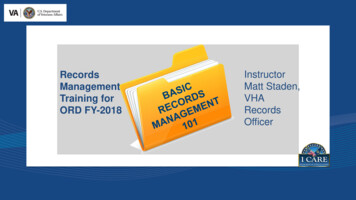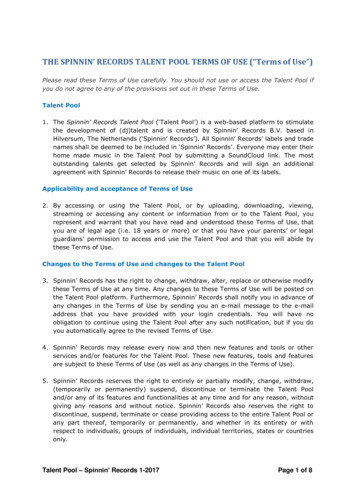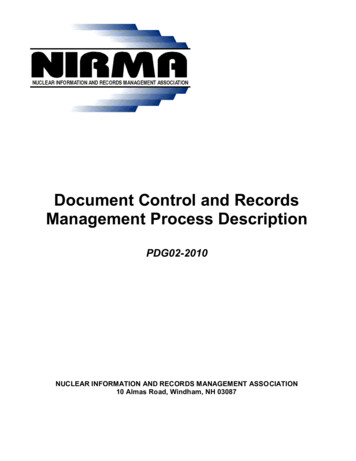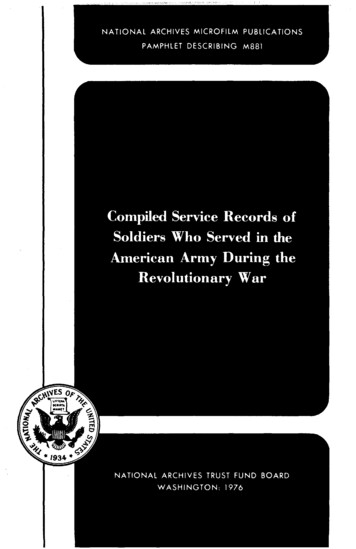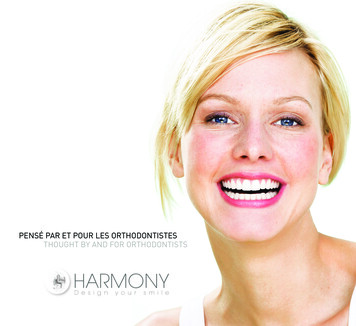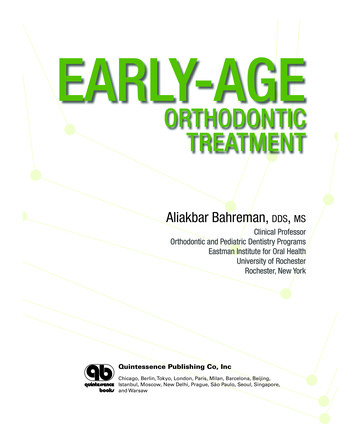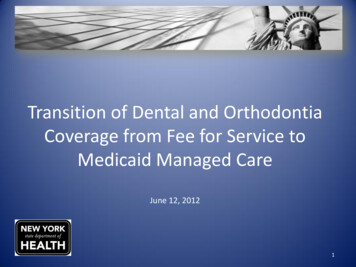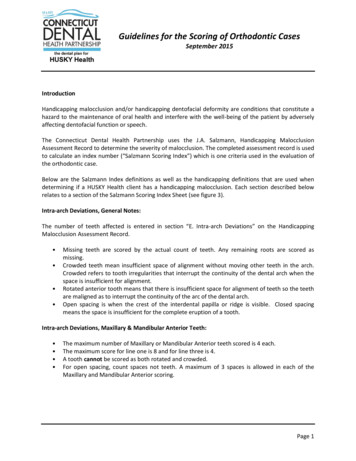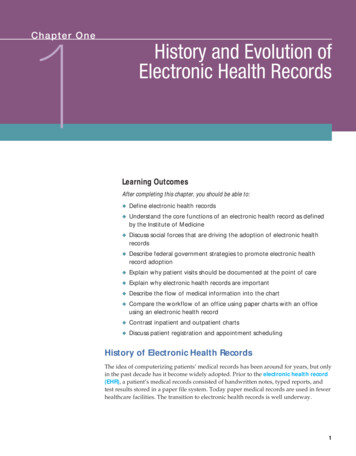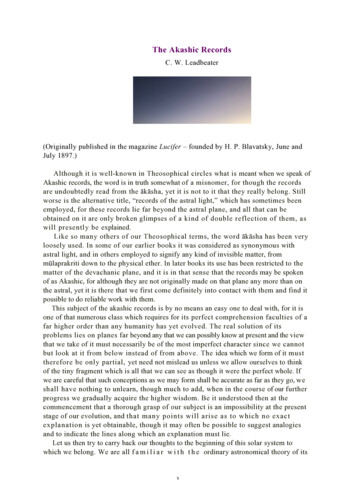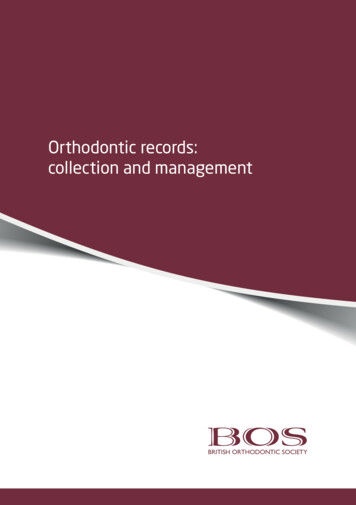
Transcription
Orthodontic records:collection and managementBRITISH ORTHODONTIC SOCIETYOrthodontic records: collection and management 1
Contents:1. Introduction42. Why are good clinical records important?43. What constitutes the clinical record?54. Writing good clinical records65. Amending clinical records76. Radiographs, photographs, study models and 3D study models 87. Confidentiality and security148. Social media179. Ownership of records1910. Access to clinical records2011. Records transfer2412. How long should records be kept for?2613. Destruction of clinical records2814. Relevant law, regulations and guidance29Appendix 1 BOS orthodontic transfer case form32Appendix 2 Guidance on retention of patient records33
1. IntroductionThis booklet replaces advice sheets: Orthodontic Records Collection and Management. Principles of Confidential Patient Information Management. Use and Storage of Digital Photographs. Orthodontic Transfer Cases.Health records are an integral part of effective patient care, their principal purpose isto record the management of a patient, documenting continuity of treatment andoutcomes.This document gives information regarding the collection and management oforthodontic clinical records and the transfer of orthodontic records. It specifiesthe principles, standards and guidance which apply to the orthodontist and allmembers of the dental team.Maintaining and protecting patients’ information is one of the nine principlesregistered dental professionals must keep at all times. (General Dental Council‘Standards for the Dental Team’, 2013).2. Why are good clinical records important?2.1 For effective and efficient orthodontic practiceClinical records are used at every consultation and are designed to provide anaccurate picture of patient treatment and care. Good clinical records are animportant means of communication between different health professionals caringfor the patient. Records must be contemporaneous, clear, concise and complete.They have most value when they are accurate, up-to-date and accessible whenrequired.2.2 For improving standards of patient careClinical records are a valuable resource because of the information they contain.Auditing clinical records is an important part of the clinical governance process andrecords should be written in a way that facilitates this process. Information withinclinical records may also be used for research.2.3 For responding to complaintsClinical records can provide vital evidence if the standard of orthodontic care iscalled into question. Many clinical negligence claims are indefensible becauserecords are inaccurate, illegible, too brief or missing. The orthodontist may have4 Orthodontic records: collection and management
done nothing wrong, but unless the clinical records support this, it can be difficultto defend a claim.Any clinical record which records any aspect of the care of a patient can be requiredas evidence. The legal approach to record keeping tends to be if it is not recorded ithas not been done’.3. What constitutes the clinical record?Clinical records include any information created by, or on behalf of, a healthprofessional in connection with the care of a patient. All healthcare professionalsare responsible for any records that they create in the performance of their duties.Orthodontic records are a working tool for the orthodontist and can cover a widerange of material: Handwritten notes.Computerised records.Referral letters.Correspondence between health professionals.Correspondence from the patient (not relating to complaints).Emails.Record of telephone conversations (telephone consultations; advice given).Radiographs and other imaging records.Laboratory or radiography reports. These should be seen and evaluated beforebeing filed in the notes. Abnormal results should be noted in the clinicalrecord and any action recorded.Photographs, videos and other recordings.Orthodontic study models.3D digital models.Statements concerning custom-made devices provided under the MedicalDevices Regulations e.g. laboratory sheets.Consent forms.NHS forms.Legal reports and correspondence relating to complaints/claims should befiled separately, because they are not part of the patient’s clinical record.Orthodontic records: collection and management 5
4. Writing good clinical recordsThe orthodontic clinical record should enable another person to reconstruct yourconsultations with the patient and show how decisions related to patient care weremade. Notes should include: Reason/s for referral.Patient’s presenting complaint.History (dental, medical and social).Details of the orthodontic examination.Description of radiographic findings and the results of any special tests.Orthodontic diagnosis - presented in clear, easily understood terms.Record of the level of treatment need e.g. IOTN.Treatment aims and options for treatment.Treatment plan/s (it should be clear from the notes how you arrived at thisplan). A copy of the treatment plan/s must be given to the patient/guardianbefore the treatment commences and a copy, signed by the patient and/or parent, should be retained as part of the clinical records. (General DentalCouncil ‘Standards for Dental Team’, 2013).Changes to the treatment plan during treatment.Details of discussions with the patient and information given, including detailsof risks and benefits of particular treatments. It is important to include detailsof all options discussed. You must check and document that the patient and/or guardian understands the information you have given to them.Details of any consent that the patient and/or guardian has given.Details of discussions with the patient and/or guardian to confirm ongoing,valid consent, at each stage of any investigation and treatment, must bedocumented.Details of treatment undertaken at each appointment, includingmeasurements as part of monitoring e.g. overjet.Details of any complications.Details of any questions asked by patient/guardian during consent process.Details of cancelled or failed appointments.Details of any discussions about patient’s non-compliance e.g. poor oralhygiene, failure to wear elastics as prescribed.Telephone messages and/or conversations relating to a patient’s care shouldbe recorded in the patient’s notes.6 Orthodontic records: collection and management
It is not only the content of the notes that is important, but also the way the notesare presented and managed: There should be one set of clinical records for each patient. Records should be readily available. The patient should be clearly identified on all clinical records by a uniqueidentifier which should be present on each record sheet. Written entries should be dated and signed. Printing the name after thesignature, or using a pre-inked stamp, is advisable, especially where thepatient receives treatment from more than one clinician. Writing should be in black ink, to allow photocopying, and should be clearand legible, so that records can be understood by anyone who may need toread and interpret them. All electronic records should clearly identify the author and should be dated. Entries should be concise; long enough to convey the essential information,but not too wordy. Records should be made contemporaneously e.g. at, or very close to, the timeof treatment. Records should be kept up-to-date and filed chronologically. Records should be factual and not include unnecessary abbreviations,jargon, irrelevant speculation or coded expressions of sarcasm. Inappropriateobservations about the patient’s or carer’s character or appearance should notbe recorded. Only defined abbreviations should be used in the notes. Abbreviations mustnever be used on consent forms. For dento-legal purposes it should be possible to make hard copies ofelectronic records. When hard copy documents are scanned for storage it isimportant to ensure there is no loss of information.5. Amending clinical records The original clinical records should not be changed unless the information isfactually incorrect. It must be clear that the correction is a new note, not an attempt to tamperwith or falsify the original record. If a mistake is discovered, an additional note should be added as a correction,stating the date of the amendment. Notes should never be erased,overwritten or inked out. Amendments to records should be immediatelyapparent using a single strike through, so that the previous entry is still legible,although obviously deleted, and the new entry clear, dated and signed.Orthodontic records: collection and management 7
Patients have a right under the Data Protection Act (1998) to have it noted ontheir records, if they dispute their accuracy. Records should only be amended ifthe original information was inaccurate, misleading or incomplete. If an entry inthe record is changed, include a note, signed and dated, to say that the incorrectinformation was altered at the patient’s request.Computer systems should also track any amendments and it should be immediatelyapparent if electronic data has been modified or altered. Although digitalphotographs, 3D scans and radiographs can be manipulated and enhanced on thecomputer, the original record must be preserved and safeguarded. There should bea full audit trail so that any amendments can be dated and alterations/erasures arenot possible.6. Radiographs, photographs, study models and 3D study modelsRecords such as radiographs, photographs, visual recordings and study models,either as hard copies or in digital format, complement the written record. To be ofvalue, these records must be of good quality.If clinical records are to be used for reasons other than clinical decision-making e.g.teaching, research, or audit, then the patient’s consent should normally be sought.Consent is always required when such records are used for publication. If systematicrecord collection is intended, ethical approval must be obtained.6.1 RadiographsRadiographs should only be taken when there is a clinical need (justification) andcomply with IRMER guidelines (2006). All radiographs should be reported on andrelevant clinical findings should be recorded in the notes.6.2 Photographic records6.2.1 ConsentPermission should always be sought from patients before photographs are taken.The DoH model consent policy (http://www.dh.gov.uk) states that expressedconsent for photographs is not required where there is no prospect of the patientbeing recognized, and where the images are to be used within the clinical settingfor education or research purposes, as long as this policy is well publicised. Where itmay be possible to identify an individual, written consent is required.8 Orthodontic records: collection and management
When taking an image of a patient, it must be explained to them: Why the image is being taken. The intended use of the image. The arrangements for storage of the image.The Institute of Medical Illustrators (IMI) has a model policy on photography(http://www.imi.org.uk). This states that it is not sufficient to rely on one individual’sinterpretation as to whether a patient can be identified from a photograph andrecommends that written consent should be obtained for all medical photography.It is good practice to reconfirm a patient’s consent, in writing, before using apatient’s photographs in a publication.The IMI have produced a photographic consent form that allows for three levels ofconsent: Medical record use only. Medical record and teaching use. One specific purpose e.g. a publication.Alternatively, the generic NHS consent form # 3, available at http://www.dh.gov.uk,can be used to gain consent for both photography and any orthodontic treatmentthe patient is to receive. This can be recorded under the heading Name ofProcedure’. In many Hospital and Community Trusts this consent form, or the Trust’sown variation, is already in use for orthodontic treatment. On the BOS consent form,specific consent for photography can be included under the heading of Additionalprocedures which might be necessary’.6.2.2 Consent for the publication of imagesWritten consent is essential for publication of any image but there is no blanketconsent for publication. A patient ticking the publication box on the consent formdoes not entitle a clinician to publish the photographs in any publication. Consentshould be gained for each specific publication of a patient’s photographs listing thetitle of each publication where the photographs will appear.Many academic papers also appear as online content, meaning that clinicalphotographs consented for publication will appear on the internet. Patients mustbe made aware that once an image has been placed in the public domain it will bedifficult to control its future use.Orthodontic records: collection and management 9
6.2.3 Young People aged 16-17Patients aged 16-17 should be treated as adults when gaining consent forphotography.6.2.4 Withdrawal of consentPatients who have consented to photography or filming have a right to withdrawthat consent at any time. Visual recordings that form part of the healthcare recordcannot be destroyed except under Retention and Destruction policies (see section13: Destruction of clinical records).6.2.5 Anonymity of imagesProviding the appropriate level of consent is obtained, making pictures anonymousis no longer an issue. Blacking out a patient’s eyes in a photograph is not acceptableas a method of avoiding the need to gain informed consent, especially whenpublication of the image is intended.6.2.6 Removable mediaDigital images are stored either on the camera’s built-in memory or on removablemedia such as SD cards. Deleting files from these cards, using the delete or formatfunction, does not permanently remove them. Only the ‘flags’ that mark where thefiles are on the card’s file structure are deleted. The actual image files remain andmay be retrieved. Removable media that has been used to take patient imagesshould never be loaned.6.2.7 CopyrightDigital photography is based on written computer code and therefore, undercopyright law, it is classed as a literary work. Digital images are thereby governedby the same rules that apply to any published material. Anyone who takes a digitalimage is the owner of that image and therefore owns the rights to it. No one elsecan use, reproduce or modify it without the permission of the owner. Organisations,such as NHS trusts, might insist on owning the copyright of their patients’ medicalillustrations. However, a patient is entitled to copies of their photographs, as theseform part of their dental records.10 Orthodontic records: collection and management
6.2.8 Digital image securityThere are several methods of protecting the authenticity of digital images. These fallinto two broad groups: Watermarking - this embeds a pattern within the image that cannot be seenby the eye, allowing any alteration of the image, in the form of cropping orrotating, to be detected. Digital signature - this works in a similar way, but the information is attachedto the image in a user-defined part of the file or an independent file.Some more sophisticated digital cameras have pixel-tracking software, whichallows any manipulation of images to be traced. Some of the dedicated dentalmanipulation and storage software programs save the original image separate fromany manipulated images.The IMI state that, until the use of tracking software to protect the integrity of theimage is common practice, the unaltered original image should be stored in anuncompressed format. Digital images form part of the patient’s confidential medicalrecord and must be subject to the same safeguards as any other data.In addition to protecting the integrity of an electronic image, physical securitymeasures also need to be considered. Basic security measures need to be employedsuch as password protection and keeping computers and backup systems, such asremovable hard drives, tapes and CDs, in a secure room.Ensure portable computers are not left unattended in clinics or whilst travelling. Ifyou are employed by a Trust, it is a requirement that images are only placed on Trustcomputers, including portable devices, and that any equipment or device on whichimages are stored are encrypted and only serviced/repaired by authorised personnel.If such a computer is to be sold, then it may also be a requirement of the Trust for thehard drive to be wiped clean of any data, by an authorised person, prior to sale.The Information Commissioner’s Office (ICO; www.ico.org.uk) indicates data onmemory sticks should be encrypted. This is also reflected in the GDC Standards forthe Dental Team Guidance which advises that if sending or storing confidentialinformation electronically, you should ensure that it is encrypted.6.2.9 Summary of advice on photographic records Seek permission prior to taking digital images. It is prudent to obtain consent prior to the taking of any digital images of a patientbut it is essential in cases in which the patient may be recognized from the image.Orthodontic records: collection and management 11
Consent should be recorded using an appropriate BOS, Trust or practiceconsent form. Record in the notes that digital images have been taken. Ensure patients understand why images are being taken, how they are to bestored and used, especially if they are to be published or placed on a website. Comply with the Data Protection Act (1998). If you work in a Trust, seek advicefrom your local Data Protection Officer. If you work in practice, check that yourcurrent registration with the Information Commissioner’s Office covers digitalphotography. Make appropriate secure arrangements for the storage of images onencrypted computers, hard drives and memory sticks. Ensure that the original unaltered image is stored in an uncompressed formaton a secure server which is backed-up on a routine basis. It is not appropriate to take clinical photographs on a camera phone. Inmost Trusts the use of camera phones to take patient images is prohibited.6.3 Study modelsPlaster study models should be of good quality and be marked with the date of theimpression and the patient’s unique identification details.6.4 3D digital study models from plaster originalsCompanies are now marketing 3D scanners which are able to duplicate and storethe information contained in a study model and allow a copy to be created at a laterstage. ‘Assuming that accurate reproduction of the model can be achieved, withoutloss of information, the scanning and photographing of models may be consideredacceptable in place of the original models’. (DPS website).Recent research concludes that the same orthodontic information can be obtainedfrom study models and photographs of study models for the purposes of medicolegal reporting (Stevens et al., 2006; Malik et al., 2009).The advantages of 3D digital study model archiving are significant in terms of cost: No future requirement to purchase study model boxes. No storage space requirement. Working models only required. Ease of transfer of records when required.12 Orthodontic records: collection and management
The case for the use of 3D digital study models from plaster originals has beenstrengthened further by the direction of the NHSBSA Dental Services to requirethe submission of 3D digital images of the original models, in STL file format, sinceFebruary 2014.The Orthodontist or contract holder must ensure that: The original plaster models are in good condition (showing all erupted teethwith no voids, chips, breakages or other deficiencies) with good extensioninto the sulci. The original study models are clearly marked and accurately trimmed to verifythe occlusion. The date of the impression is clearly marked on the original plaster models. The 3D digital images of the original plaster models are produced in STL fileformat. An individual file needs to be provided for each of the upper andlower arches. The orientation of each file should be such that when openedtogether the models are presented in the correct occlusion. The laboratory provides 2 password-protected CDs containing the 3D imagesin STL file format - one to be retained and one for forwarding to NHS DentalServices. The 3D digital images are checked before being sent to the NHS DentalServices to ensure that they accurately represent the patient’s dentition andocclusion. The original plaster models are retained until the NHS Dental Servicesreporting process has fully concluded.The laboratory/3D digital image supplier must ensure that: The original plaster models are in good condition (showing all erupted teethwith no voids, chips, breakages or other deficiencies) with good extensioninto the sulci. The original plaster models are clearly marked and accurately trimmed toverify the occlusion. The 3D digital images accurately reproduce all of the features of the plasteroriginals. The 3D digital images are dated as per the date of the impression (not thedate of the scanning). The 3D digital images of the original plaster models are produced in STLfile format. An individual file shall be provided for each of the upper andlower arches. The orientation of each file should be such that when openedtogether the models are presented in the correct occlusion.Orthodontic records: collection and management 13
The plaster originals are returned to the orthodontic contract holder insuitable packaging to ensure that damage does not occur in transit. The laboratory provides 2 password-protected CDs containing the 3D imagesin STL file format - one to be retained by the contract holder and one forforwarding to NHS Dental Services.6.4.1 Storage of 3D digital imagesAs with all computerized records, it is important that digital images are securelystored and access to the images is subject to an audit trail to ensure that noallegations could be made that the images have been manipulated in any way.7. Confidentiality and securityPatients have a right to expect that a healthcare professional will not disclose anypersonal information that is learnt during the course of their professional duties,unless the patient gives their permission or statute permits otherwise.A duty of confidentiality is a professional, ethical, and often contractual obligation.The rights to privacy and confidentiality are enshrined in the European Conventionon Human Rights, in the Data Protection Act (1998) and in common law. It is notjust because the law demands it that we are concerned with this issue, ratherthat the law reflects what we know to be right; that privacy and confidentialityare important values to be protected. The functional purpose of confidentialityis probably the most important as it encourages patients to be honest with ahealthcare professional, when they provide information. This benefits patientsindividually, and society collectively e.g. communicable diseases do not gountreated and unchecked because of people’s fear about who might be told.Confidentiality is an important duty, but it is not absolute. You can disclose personalinformation if: It is required by law. The patient consents. It is justified in the public interest.14 Orthodontic records: collection and management
7.1 The uses of patient dataPersonal patient data cannot be used for any purposes other than healthcare,without the explicit consent of the patient. An exception to this is anonymizeddata which can be used with fewer limitations. All members of staff, clinical andnon-clinical, are bound by this duty. Since 2011 in England it is a requirement for allhealth and social care providers, who carry out one of the 15 regulated activities, tobe registered with the Care Quality Commission (CQC).Providers will need to have policies in place on confidentiality, data protection anddata security.In Northern Ireland, it is also a requirement that dental practitioners who workoutside the NHS are registered and regulated by the RQIA (Regulation and QualityImprovement Authority).7.2 Data Protection Act (1998)The Data Protection Act is the main legislation underpinning the principles ofpersonal data management. Breaches of the Act are a criminal offence and canincur a considerable fine, or even a custodial sentence. A data controller is a personwho, alone, jointly or in common with others, determines the purpose and mannerin which any personal data is to be processed.‘Processing’ refers to the obtaining, storing, holding, using, and disclosing ofinformation which can identify a living human being and it refers to both paper anddigital records. Medical and dental information is classified as ‘sensitive personaldata’ in the Data Protection Act and is subject to more stringent conditions thanother data.The data controller is required to notify the Information Commissioner’s Office(Wycliffe House, Water Lane, Wilmslow, Cheshire SK9 5AF; http://www.ico.gov.uk)and comply with the eight Data Protection Principles: Processed fairly and lawfully.Processed for one or more specified and lawful purposes.Be adequate, relevant and not excessive.Accurate and, where necessary, kept up to date.Kept for no longer than is necessary for the purpose for which it is being used.Processed in line with the rights of individuals.Orthodontic records: collection and management 15
Kept secure with appropriate technical and organisational measures taken toprotect information. Not be transferred outside the European Union unless there is adequateprotection for the personal information being transferred. Patients movingabroad, outside the EEC, where there may be an inadequate level ofprotection in relation to the processing of personal data, must be fullyinformed and should consent to their data being transferred.Under the Data Protection Act, the data controller must take reasonable steps toguarantee that data is safe from unauthorised access, disclosure, tampering or loss.This will include installing security arrangements such as password protection, theuse of encrypted devices, regular computer back-ups for digital data and ensuringthat all individuals, who have access to the records, are instructed about the needfor confidentiality.7.2.1 Dental practice and the Data Protection Act (1998)All dentists in general and specialist practice should be registered with theInformation Commissioner, even if their practice is not computerised, becausethey hold personal information that is filed in such a way that it can be directlytraced to the patient. The introduction of digital images would require a changein notification, not a new entry. Advice should be sought from the InformationCommissioner’s Office (www.ico.gov.uk).In the practice setting, principal orthodontists, associates, and single-handedorthodontists are all required to be individually registered as data controllers. Whereassociates work in more than one practice only one notification is required togetherwith a list of the other sites of work. Where a legal partnership exists the practiceis required to register as a single controller. Assistants and locum orthodontists,depending on their contractual relationship, are not required to be individuallyregistered if using the data for healthcare purposes, but will usually be contractuallyobliged to abide by the data protection principles. In addition, all clinicians,regardless of where they work, are bound by an ethical duty of confidentiality.7.2.2 Hospital Trusts and the Data Protection Act (1998)In most Trusts, clinicians will already be covered by the Trust/University dataregistration, provided they comply with the local rules of the Trust. Trusts treat thestorage of data extremely seriously and now state that data should not be storedon any portable devices unless it is within an encrypted folder. Free encryptionsoftware can be downloaded from www.truecrypt.org. In some Trusts, employees,16 Orthodontic records: collection and management
including trainees who copy and store images for their own purposes, may beconsidered independent data controllers and will be required to register withthe ICO. It is therefore important that you seek advice from your Trust’s local DataProtection Officer.7.3 SecurityIt is the responsibility of all healthcare professionals to keep all orthodontic recordssafe. All clinical records should be kept in a secure environment. Unauthorised orunlawful access should not be possible. That means restricting access to authorisedpersonnel and ensuring that records are kept physically safe. Care should be takento ensure that unintentional breaches of confidence do not occur. Even if namesand addresses are removed, the combination of date of birth and postcode canallow individuals to be identified. Do not leave files/computer terminals unattended or unsecured. Log out orlock your screen when leaving your desk. Avoid transmitting information to the wrong person or fax machine. Do not allow sensitive conversations to be overheard. The need for a case note tracking mechanism if records are passed on to athird party. Fire precautions - an alarm system, sprinklers and ‘no smoking’ signs. Preventing damage from damp, flooding or pests. Staff awareness of duty to prevent unauthorised disclosure and guard againstpeople seeking information by deception. Passwords, encryption software and restricted access for staff. Never share your Username and Password information. The need to back up all computer data to prevent accidental loss. Computer repairs - ensure these are carried out on the premises or in a secureenvironment with a confidentiality agreement. Also consider if the softwareprovider has access to the records. Keeping records in locked cabinets.8. Social mediaFacebook, Dig, Leakernet, MySpace, Hi5, Last.FM, Twitter, YouTube, Blogs etc.Social media is an increasingly powerful way of engaging and communicatingwith target audiences, peers, professional bodies and the public. Th
Statements concerning custom-made devices provided under the Medical Devices Regulations e.g. laboratory sheets. Consent forms. NHS forms. Legal reports and correspondence relating to complaints/claims should be filed separately, because they are not part of the patient's clinical record.
